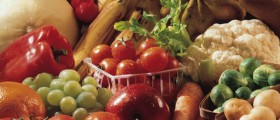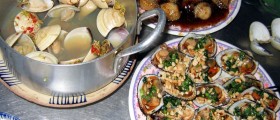
Group B vitamins are soluble in water. These are: B1, B2, B3, B5, B6, B7, B9 and B12.
Vitamin B1
The main role of vitamin B1 – thiamine is regulating the function of the nervous system, cardiovascular system, muscles and the digestive tract. Lack of vitamin B1 may cause polyneuropathic symptoms, senility and poor memory. Foods that are rich in B1 include: whole grain bread, wheat bran, brown flour, black rice, peas, beans, green beans, spinach, hazelnut, walnut, almond, orange, tomato, pork, liver, heart, kidney, fish, egg yolk, and yeast.Vitamin B2
Vitamin B2 - riboflavin is a part of enzymes that participate in the process of oxidation of cells and cellular respiration. Lack of vitamin B2 causes reduced amount of oxygen in the cells. Deficiency of this vitamin leads to gum inflammation, skin cracking, especially at the corners of the mouth and anemia and often conjunctivitis. Foods rich in this vitamin are liver, milk, meat, green vegetables and cereals.Vitamin B3
Vitamin B3 - niacin participates in the transfer of oxygen in cellular respiration, preventing the creation of thrombus, in the metabolism of fats, carbohydrates and proteins. Lack of niacin causes pellagra, disease that is characterized by rough and red skin, very red tongue, depression, loss of appetite, dementia, and even death. Natural sources of vitamin B3 are: whole grain bread, brown bread, brewer's yeast, bran, peas, pork liver, tuna, herring, meat, rice, nuts, dairy products, tomato puree, soy.Vitamin B5
Vitamin B5- pantothenic acid actively participates in the metabolism of carbohydrates (sugar), and its lack can lead to frequent hypoglycemia in diabetics who use insulin. It belongs to the group of anti-stress vitamins, affects skin pigmentation, and its lack can lead to anemia and fatty liver. It is useful in the treatment of sneezing, helps healing wounds, and reduces the intensity of allergic reactions. It can be easily destroyed by heat and freeze.Foods which abound with pantothenic acid include: yeast, brewer's yeast, offal, dark chicken and turkey meat, beans, mushrooms, egg yolk, peanuts, salmon, grains (wheat, oats, rice), bran, lemon and other citrus fruits.
Vitamin B6
Vitamin B6 - pyridoxine is one component of the enzymes that ease the transport of amino acids from the intestine into the bloodstream. Lack of vitamin B6 plays an important role in the process of atherosclerosis.Also, vitamin B6 is very important in the diet and treatment of diabetes because, in addition to direct effects on the metabolism of carbohydrates (sugar), acts as a therapeutic tool for pain, neuropathy, painful shoulder, carpal tunnel syndrome. Foods rich in vitamin B6 are yeast, meat, fish, offal, legumes, green vegetables, potatoes, tomatoes, cereals, milk and dairy products, bananas, potatoes, some flour.
Vitamin B9
The most important role of folic acid is in the growth and reproduction of cells, synthesis of hemoglobin and the proper development of red blood cells. The main sources of folic acid are: green leafy vegetables, Brussels sprouts, root vegetables, liver and kidneys, milk, eggs, peas, peanuts, whole grain cereals, tomatoes, tuna, oysters, salmon, bakery yeast, asparagus.Vitamin B12
Vitamin b12 - Cyanocobalamin participate in the metabolism of some protein (purine and pyrimidine) and the maturation of erythrocytes.Lack of vitamin B12 leads to anemia (fatigue, difficult breathing, rapid heart rate, chest pain), loss of appetite, belching, diarrhea, depression, decreased sex drive, cramps and annealing in the feet.
This vitamin can be found only in foods of animal origin - liver, fish, venison, canned sardines, eggs and meat and milk products.

















Your thoughts on this
Loading...